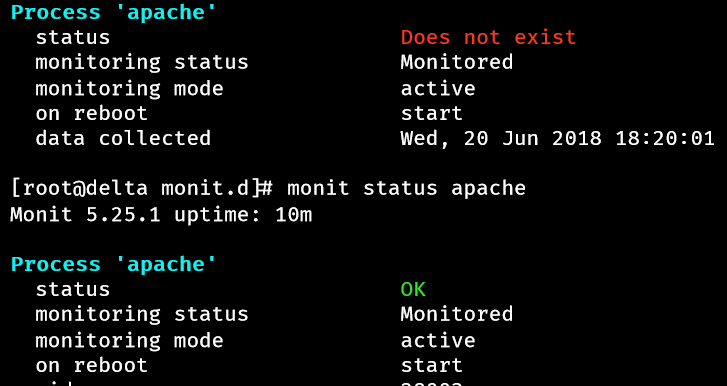Argos is a monitoring and notification relay engine for apnscp. It provides enhanced monitoring for Monit, which is a lightweight, proactive monitoring service for Linux. Monit relays service alerts through Argos, which can use one of several backends including Pushover, XMPP, Slack, and webhooks to relay notifications. We recommend pairing Argos with Pushover to receive alerts on your phone, but any backend works with varying levels of features. Pushover includes quiet hours and user interaction for major events, such as maxing out storage or a database outage.
Argos comes installed with apnscp and begins monitoring immediately, but you'll need to perform some activation steps to enable push notifications to your phone.

Changing monitoring parameters
Any tweaks can be made in /etc/monit.d/ following Monit's documentation. To reload Monit, issue sudo systemctl reload monit. All configuration values shipped with Argos are what we recommend and utilize for our servers.
Creating an Argos backend
First, setup an account with Pushover and download the app to your phone. Alternatively the following backends are supported for Argos:
- notifico
- pushbullet
- pushjet
- pushover
- simplepush
- slack
- systemlog
- xmpp
Additional modules can be configured and setup by hand in
/root/.argos.confwithout using apnscp's API to configure Argos. Documentation for all backend relays are provided with ntfy's documentation.
Initialize Argos configuration:
cpcmd config_set argos.init 1
Let's take a look at the YAML created in /root/.argos.conf. As a supplement, any YAML tutorial is a great starting point.
---
# Default backend invoked with:
# ntfy send "msg"
backends:
- default
# Backend configuration
# See also https://github.com/dschep/ntfy
default: &default
backend: pushover
# May be overridden with -t title
title: "nexus"
api_token: TOKEN
user_key: KEY
# High priority backend ntfy -b high send "msg"
high:
title: "❗ nexus"
priority: 2
expire: 3600
retry: 120
<<: *default
- Two channels are created, default and high, which are hardcoded into Argos as low/high channels.
- backends denotes the default backends to send to when no channel is configured (
cpcmd argos_send "Test Message"). - default is a low priority channel that uses Pushover to relay messages.
- high is a high priority channel that inherits configuration from default (
<<: *default) - Both channels (default and high) require a backend provider to relay the messages. Both use pushover (
backend:in default channel)
api_token and user_key need to be set for relays to work. You can edit the YAML by hand or use apnscp. Head over to Pushover to create an application token, which is unique to the monitoring application; and user_key is your user key.
Setting relay authentication
Each backend has different authentication parameters. These are baked into argos.auth but can be set freeform too.
cpcmd config_set argos.auth '' USERKEY
# is equivalent to...
cpcmd argos_config high '[user_key:USERKEY]'
cpcmd argos_config default '[user_key:USERKEY]'
Pushover requires one additional configuration parameter, API token:
cpcmd config_set argos.config '' '[api_token:APITOKEN]'
# Alternatively...
cpcmd argos_config default '[api_token:APITOKEN]'
cpcmd argos_config high '[api_token:APITOKEN]'
Now test sending a relay through each backend:
cpcmd argos_test
cpcmd argos_test high
You can use Argos to relay messages at your leisure to configured channels. Of course apnscp needs to be operable for it to work, so this won't work when MySQL is down!
cpcmd argos_send "Some Message" high "Test Title"
Alternatively you can use ntfy directly, which works if MySQL is down,
ntfy -c /root/.argos.conf -b high -t "Test Title" send "Some Message"
Verifying Monit => Argos notification
Once set, kill Apache to make sure everything works,
systemctl stop httpd
monit validate
A push notification should arrive to your phone nearly instantaneously. Now confirm the status has changed, then re-run validate to update Monit's internal record and generate a second notice to confirm everything is OK.
monit status apache
monit validate
monit status apache

Switching backends
Pushover comes highly recommended because of its features, but you can exchange pushover with any supported monitoring interface. To exchange with the apnscp API, use argos_config(),
cpcmd argos_config default '[backend:slack]'
# Or alternatively
cpcmd config_set argos.backend high default
- default now uses slack for its backend relay
- high depends upon the configuration from the default channel for its inherited configuration
- default requires reconfiguration with
cpcmd argos.auth default '[token:slacktoken,recipient:#somechannel]'
When installing Slack, be sure to install its dependency,
pip install ntfy[slack]
Stacking backends
Multiple channels may be stacked into a channel to expand notification. It requires creating a new channel, then enrolling the channel as a backend into either default or high unless you want to relay through a separate channel.
cpcmd argos_create_backend slack-relay slack
cpcmd argos_config slack-relay '[token:slacktoken,recipient:#somechannel]'
# Stack slack-relay onto default
cpcmd argos_set_default '[default,slack-relay]'
cpcmd argos_test slack-relay
# Alternatively...
ntfy -c /root/.argos.conf -b slack-relay send 'Test!'
backends now looks like:
backends:
- default
- slack-relay
And calling argos_send without specifying a backend channel will relay the message through default and slack-relay.
Robust monitoring
Argos works great to monitor internally, but what happens if a server goes down? A remote third-party service, such as Hyperspin that monitors externally + provides Pushover integration is a great complement to internal monitoring with Argos. It's what we have used for our servers since 2010 and whole heartedly recommend using. The owner is a nice guy to boot!


